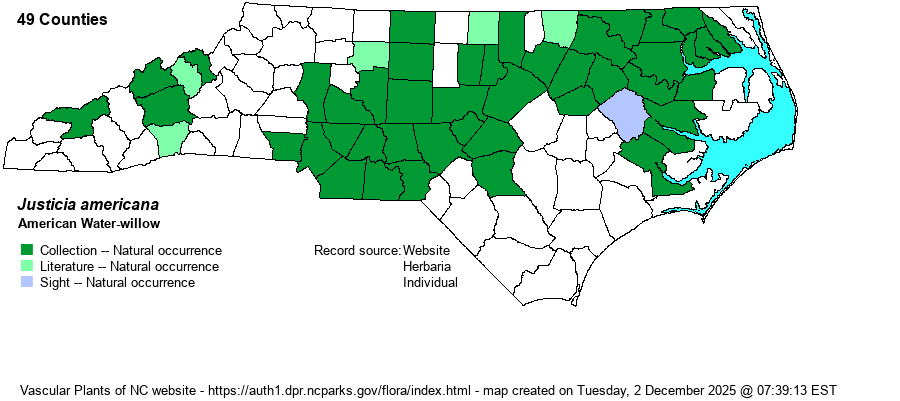| Author | (L.) Vahl | |
| Distribution | Present over much of the Coastal Plain and Piedmont, with gaps in the range; scarce in the Mountains, with records from just six counties. Seemingly absent from the coastal areas and the southern quarter of the Coastal Plain (south of Craven and Cumberland counties) and the Sandhills proper. Also seemingly absent from the western Piedmont, for no obvious reason.
This is a widespread Eastern species, ranging from VT, MI, and NE south to western FL and TX. Oddly, though it ranges over essentially all of VA, there seems to be no southward extension of records into the western Piedmont or northern mountains in NC. | |
| Abundance | Fairly common to common, at least locally, in the eastern 2/3rds of the Piedmont, though locally scarce in this area. Infrequent to fairly common in the northern half of the Coastal Plain, but rare in the central portions. Rare -- oddly so -- in the Mountains, as rocky stream habitats are quite common. | |
| Habitat | This is an aquatic plant, growing in shallow flowing water, such as in rocky river beds and those of larger streams; mostly in brownwater situations. It also grows in the Coastal Plain along some sandy creeks and rivers, generally along the margins. |
| Phenology | Blooms from June to October, and fruits shortly after flowering. | |
| Identification | This is an unusual plant, one of the few showy-flowered species that grows in rocky rivers, in often swiftly flowing waters. It is quite colonial, reaching about 2 feet tall; it may have branches at the base, but otherwise appears unbranched. It has numerous opposite leaves, very narrowly elliptic to linear, about 4-5 inches long but barely 1/2-inch wide, with entire margins. The flowers grow in several dense clusters, on very long and ascending stalks of a few inches; each flower is quite attractive up close, being white with fancy purple markings on the lower lip. The flower has a double lip on top, two widely flaring petals to the sides, and a bottom lip, and each flower has a spread of about 3/4-inch. Even without the flowers, you should be able to identify the species, as it grows in dense stands with erect stems and narrow opposite leaves, but the flowers will certainly clinch it. Note, however, that most plants grow "out in the water" well away from shore, so you may need to wade in the water to study them, or study them through binoculars. | |
| Taxonomic Comments | None
| |
| Other Common Name(s) | Water-willow | |
| State Rank | S4S5 | |
| Global Rank | G5 | |
| State Status | | |
| US Status | | |
| USACE-agcp | OBL link |
| USACE-emp | OBL link |

